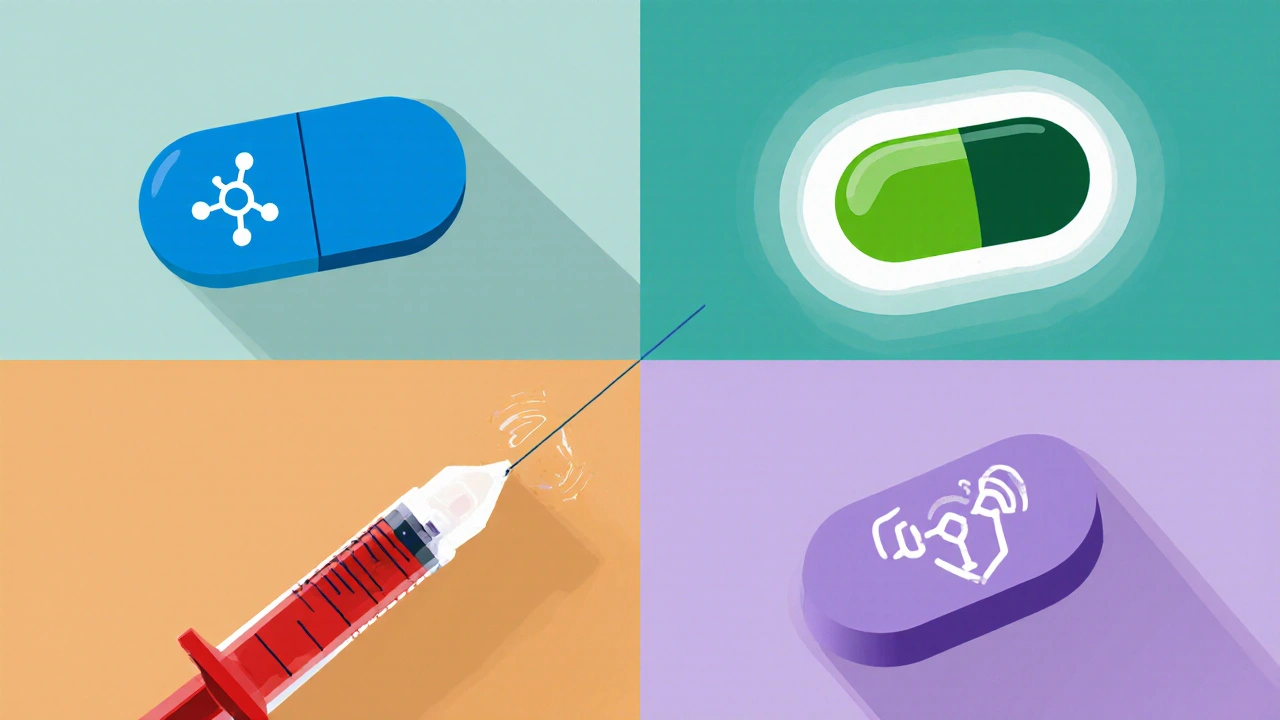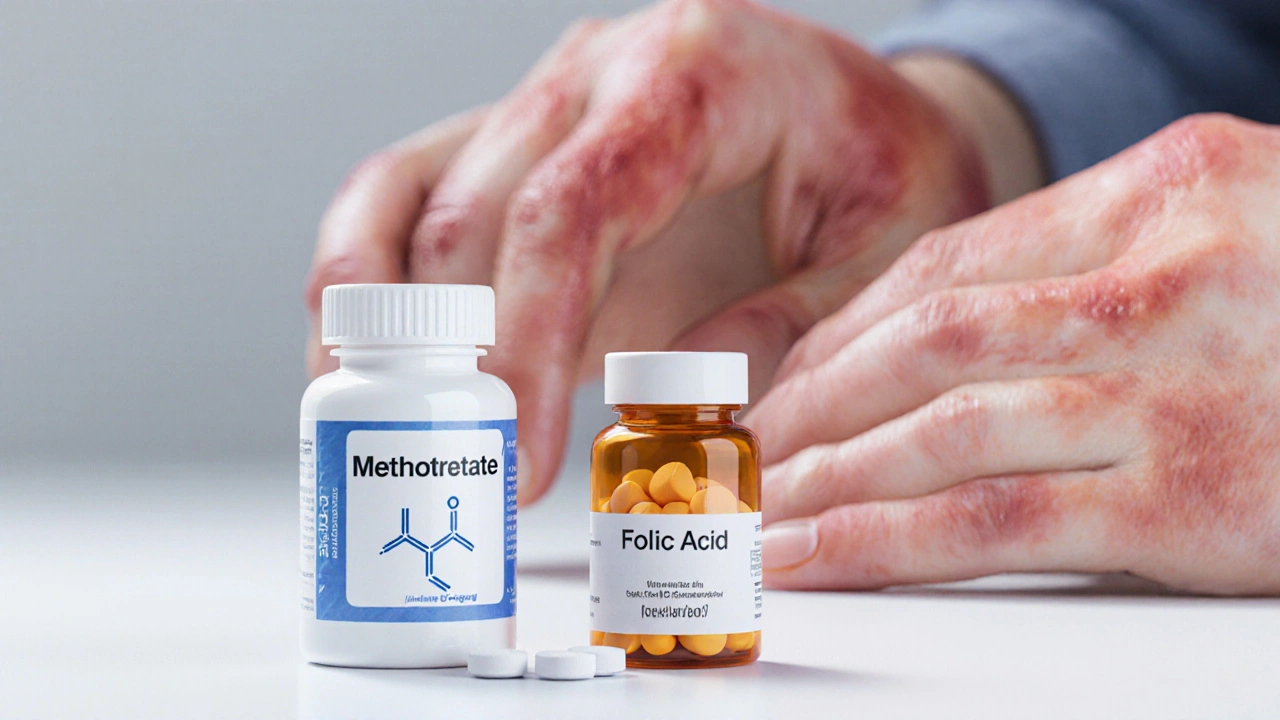Methotrexate vs Alternatives Comparison Tool
Methotrexate
First-line DMARD for RA and psoriasis
Biologics (e.g., Adalimumab)
Target specific immune proteins
Leflunomide
Pyrimidine synthesis inhibitor
JAK Inhibitors (e.g., Tofacitinib)
Oral pills targeting cytokines
Compare Key Features
| Feature | Methotrexate | Leflunomide | Biologics | JAK Inhibitors |
|---|---|---|---|---|
| Mechanism | Folate antagonist | Pyrimidine synthesis inhibitor | TNF-α blocker | JAK1/3 inhibitor |
| Route/Dosage | Oral 7.5-25 mg weekly | Oral 20 mg daily | Subcutaneous 40 mg every 2 weeks | Oral 5 mg twice daily |
| Time to Effect | 8-12 weeks | 6-8 weeks | 4-6 weeks | 2-4 weeks |
| Major Side Effects | Nausea, liver toxicity, mouth sores | Liver toxicity, hypertension | Infections, TB reactivation | Thromboembolism, hyperlipidemia |
Personalized Recommendation Engine
When doctors prescribe a disease‑modifying drug for rheumatoid arthritis, psoriasis, or certain cancers, methotrexate is often the first name that pops up. Yet the market is crowded with other options that promise similar benefits with different side‑effect profiles. This guide walks you through the most common alternatives, compares how they work, and helps you decide which one might fit your lifestyle and health goals.
Quick Take
- Methotrexate is a cheap, oral DMARD with well‑known efficacy for rheumatoid arthritis.
- Leflunomide offers once‑daily dosing but can raise liver enzymes more often.
- Biologic agents such as adalimumab target specific immune proteins and work fast, but they cost a lot.
- JAK inhibitors like tofacitinib are oral, act quickly, and have newer safety data to watch.
- Folic acid supplementation reduces methotrexate‑related mouth sores and liver impact.
What Is Methotrexate?
Methotrexate is a synthetic folate antagonist that inhibits dihydrofolate reductase, slowing cell division and dampening inflammatory pathways. Approved in the 1950s for cancer, it was repurposed in the 1980s as a disease‑modifying antirheumatic drug (DMARD). Typical weekly oral doses range from 7.5mg to 25mg, often combined with folic acid to offset side effects. In rheumatoid arthritis (RA), methotrexate reduces joint swelling, slows radiographic damage, and improves quality of life for roughly 60% of patients.
Why Look at Alternatives?
Not everyone tolerates methotrexate. Common issues include nausea, fatigue, liver enzyme elevation, and rare lung toxicity. Some patients need a faster response or have contraindications such as pregnancy or severe liver disease. Knowing the trade‑offs helps you and your clinician design a personalized plan.
Key Alternatives at a Glance
Below are the most frequently considered substitutes, each with a distinct mechanism and safety profile.
Methotrexate vs Leflunomide
Leflunomide is a pyrimidine synthesis inhibitor that blocks the enzyme dihydroorotate dehydrogenase, curbing lymphocyte proliferation. It’s taken once daily, usually 20mg, making adherence easier. Efficacy in RA mirrors methotrexate, but liver toxicity and hypertension appear more often. Unlike methotrexate, leflunomide has a long washout period-if a pregnancy is planned, a cholestyramine purge may be needed for up to three weeks.
Biologic DMARDs (e.g., Adalimumab)
Adalimumab is a fully human monoclonal antibody that binds tumor necrosis factor‑α (TNF‑α), blocking inflammatory signaling. Administered by subcutaneous injection every two weeks, it often shows clinical improvement within 4-6 weeks-much faster than methotrexate’s 8‑12‑week window. The trade‑off is cost (often >$2,000/month in the U.S.) and a heightened risk of infections, including reactivation of latent tuberculosis.

JAK Inhibitors - Tofacitinib
Tofacitinib belongs to the Janus kinase (JAK) inhibitor class. By blocking JAK1 and JAK3, it interferes with cytokine signaling that drives inflammation. It comes as a 5mg oral tablet taken twice daily, offering the convenience of a pill with a rapid onset-often noticeable within 2-4 weeks. Safety warnings focus on increased risk of venous thromboembolism and elevated lipid levels, especially in patients over 50 with cardiovascular risk factors.
Older Conventional DMARDs: Sulfasalazine & Hydroxychloroquine
Sulfasalazine is a sulfonamide‑based agent that modulates immune response, usually dosed at 500-1,000mg twice daily. It’s well‑tolerated but less potent than methotrexate, making it a good add‑on for mild disease.
Hydroxychloroquine is an antimalarial that interferes with antigen presentation, typically prescribed at 200-400mg daily. Its safety profile is favorable, but retinal toxicity mandates annual eye exams. As a solo DMARD, it rarely controls moderate‑to‑severe RA.
How to Choose the Right Option
- Severity of disease: For early‑stage RA, methotrexate or leflunomide often suffice. Moderate‑to‑severe disease may require a biologic or JAK inhibitor.
- Speed of relief needed: If symptoms are crippling, a biologic or JAK inhibitor offers quicker control.
- Comorbidities: Liver disease steers you away from methotrexate and leflunomide; heart disease may caution against JAK inhibitors.
- Pregnancy plans: Methotrexate is teratogenic; leflunomide requires a washout; biologics like certolizumab have more pregnancy data.
- Cost and insurance coverage: Oral DMARDs are inexpensive; biologics and JAK inhibitors often need prior authorization.
Side‑Effect Management Tips
- Folic acid supplementation: Folic acid (1mg daily) reduces methotrexate‑related mouth sores and liver enzyme spikes.
- Monitor liver function tests (LFTs) every 8-12weeks for methotrexate and leflunomide.
- Screen for tuberculosis before starting any TNF‑α blocker.
- Check lipid panels when initiating tofacitinib and treat hyperlipidemia if needed.
- Stay hydrated and avoid alcohol while on methotrexate to lessen liver stress.
Comparison Table
| Drug | Mechanism | Typical Route / Dose | Time to Effect | Major Side Effects |
|---|---|---|---|---|
| Methotrexate | Dihydrofolate reductase inhibition (folate antagonist) | Oral, 7.5‑25mg weekly | 8‑12weeks | Nausea, liver enzyme rise, pulmonary toxicity, mouth sores |
| Leflunomide | Dihydroorotate dehydrogenase inhibition (pyrimidine synthesis) | Oral, 20mg daily | 6‑8weeks | Liver toxicity, hypertension, rash |
| Adalimumab | TNF‑α monoclonal antibody | Subcutaneous injection, 40mg q2wks | 4‑6weeks | Serious infections, TB reactivation, injection site reactions |
| Tofacitinib | JAK1/3 inhibition | Oral, 5mg BID | 2‑4weeks | Thromboembolism, hyperlipidemia, infections |
Real‑World Scenarios
Case 1 - Young adult with early RA: A 28‑year‑old starts methotrexate 15mg weekly plus folic acid. After three months, joint counts improve, and LFTs remain normal. She prefers oral dosing and can afford the cheap regimen.
Case 2 - Middle‑aged patient with liver disease: A 52‑year‑old with non‑alcoholic fatty liver disease can’t tolerate methotrexate. The rheumatologist switches to adalimumab, monitoring for infections. Symptoms subside within six weeks, and liver enzymes stay stable.
Case 3 - Patient needing rapid control before surgery: A 61‑year‑old awaiting joint replacement needs swift inflammation suppression. Tofacitinib is chosen for its fast onset, with anticoagulation precautions because of age‑related clot risk.
Bottom Line
There’s no one‑size‑fits‑all answer. Methotrexate remains the workhorse because it’s cheap, effective, and backed by decades of data. Alternatives shine when speed, safety, or convenience become priority. Discuss your disease activity, lifestyle, and any existing health issues with your specialist-together you’ll land on the therapy that balances benefit and risk for you.

Frequently Asked Questions
Can I take methotrexate and a biologic at the same time?
Yes, many rheumatologists use methotrexate as a backbone therapy with a biologic (e.g., adalimumab). The combination can improve response rates, but liver function and infection risk need closer monitoring.
Is folic acid required with methotrexate?
While not mandatory, most clinicians prescribe 1mg daily to reduce mouth sores, nausea, and liver enzyme spikes. Skipping it may increase side‑effects without improving efficacy.
How long should I stay on methotrexate before trying something else?
Typically 12‑16weeks at an optimal dose. If disease activity (e.g., DAS28 score) hasn’t improved by at least 20‑30%, a switch or addition of another DMARD is considered.
Are JAK inhibitors safe for patients with a history of blood clots?
They carry a higher clot risk, especially in people over 50 with cardiovascular factors. Doctors usually avoid JAK inhibitors in such patients or use the lowest effective dose with close monitoring.
What labs do I need before starting methotrexate?
Baseline CBC, liver function tests, renal panel, and hepatitis B/C screening. Repeat LFTs and CBC every 8‑12weeks during the first six months, then quarterly.



Listen up, dear readers, because the pharmaceutical giants have been dancing around the truth for decades, and this guide is a perfect illustration of the smoke and mirrors they love to throw at us. First, the cheap allure of methotrexate is nothing more than a clever PR stunt to keep the market flooded with a drug that can be hoarded in your kitchen cabinet while the same companies push pricey biologics onto unsuspecting patients. You see, the mechanism-folate antagonism-sounds scientific, but under the hood it's a blunt tool that forces cells to scramble for folic acid, leading to those dreaded mouth sores and liver glitches we all learn to tolerate in silence. Meanwhile, the sleek, subcutaneous injections of adalimumab are marketed as the future, yet they come with a hidden clause: an ever‑growing dependency on a single corporate pipeline, which in turn fuels the ever‑increasing health‑care bill. And let’s not forget the JAK inhibitors-those little pills that promise miracles in two to four weeks, but conveniently ship a side‑effect dossier of thrombosis that most patients never see until it’s too late. The consensus among insiders, whispered in hushed conference rooms, is that each alternative is simply a way to keep the profit wheel turning while offering the illusion of choice. As if that wasn’t enough, the dreaded liver toxicity warnings are often buried in footnotes, a tactic that feels more like a treasure hunt than transparent communication. And what about the environmental impact of manufacturing these biologics? The carbon footprint of massive bioreactors is a secret the industry guards zealously, while we’re left to wonder if our joints are the only thing being drained. Yet, amidst this labyrinth of deceit, there remains a glimmer of hope: patient advocacy groups that are finally demanding real data, not just glossy charts. They push for head‑to‑head trials that truly compare methotrexate to its shiny cousins, and they demand that insurers stop playing gatekeeper with life‑changing therapies. So, the next time your doctor whispers “start methotrexate” in a hushed tone, remember the hidden agenda and ask the hard questions. After all, knowledge isn’t just power; it’s the only weapon we have against the corporate pharmaco‑imperialism that seeks to dictate our health outcomes.
Stay vigilant, stay informed, and don’t let the slick marketing jargon blind you to the real risks and costs.
Great rundown of the options! Methotrexate is still the go‑to for many because it’s cheap and effective, but if you need faster relief, a biologic or JAK inhibitor can be a game‑changer. Just keep an eye on liver tests and watch for infections with the biologics.
Honestly, this article tries too hard to be neutral!!!
It’s obvious that the author is scared to take a stance-what a coward!!!
People need to know that meth‑dose failures are rampant, and the “quick relief” of biologics comes with a price tag that fuels the pharma machine!!!
Don’t be fooled by the tables-they hide the real cost in the fine print!!!
The comparison table is accurate, though the phrasing could be tightened. Ensure that liver function monitoring is emphasized for both methotrexate and leflunomide.
lol this reads like a pharma catalog 😂 meth is cheap but why not just go for the fancy jabs? gotta love those new meds 🤷♀️
I appreciate the thoroughness here. For anyone on a tight budget, starting with methotrexate and folic acid is a sensible approach before moving to pricier biologics.
From a pharmacokinetic perspective, the oral bioavailability of methotrexate versus the subcutaneous absorption kinetics of adalimumab offers distinct therapeutic windows. The JAK/STAT pathway inhibition by tofacitinib provides a rapid cytokine blockade, which can be crucial in acute flare management, though clinicians must balance the thrombosis risk profile.